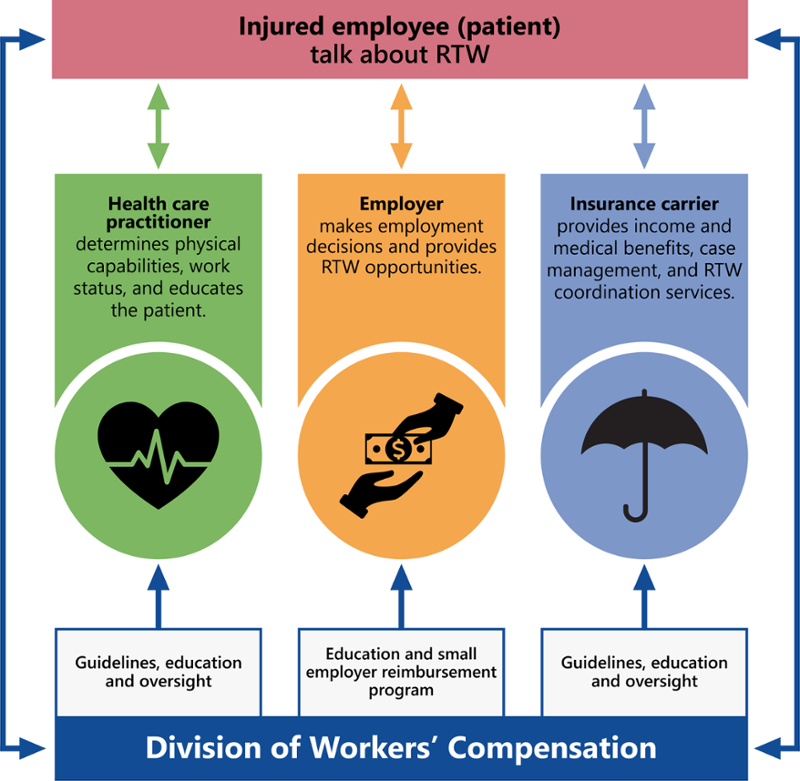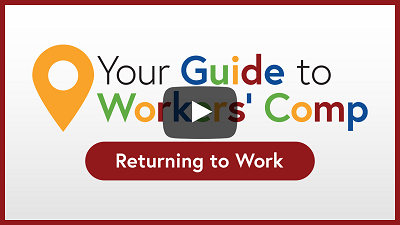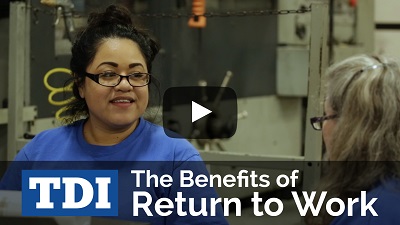
Return to work (RTW)
Returning to work after an injury benefits employees and their employers. DWC can help employers start a successful RTW program and help health care providers support and encourage the safe RTW for injured employees. Contact RTW.Services@tdi.texas.gov for details.
Recursos en español para el regreso al trabajo.
Return to work
Injured employees who RTW:
- heal faster;
- keep job-related benefits;
- reduce financial losses;
- stay employed;
- maintain physical and emotional health; and
- avoid long-term disability.
Injured employees should:
- talk to their doctor about duties and tasks they perform at work;
- ask the doctor what they can do safely during recovery;
- talk to their employer about getting back to work as soon as possible; and
- follow the doctor’s orders at work and at home.
RTW is a shared responsibility
The longer an employee is away from work, the higher the employer's workers' compensation and related business costs. An employer who helps injured employees RTW:
- reduces their workers’ compensation costs;
- retains skilled employees;
- eliminates absences; and
- avoids costly staff turnover.
It is the employer’s responsibility to:
- provide a safe work environment;
- encourage and help injured employees RTW;
- answer any questions the health care provider may have about job tasks and duties (may use DWC Form-074 Description of Injured Employee’s Employment);
- find meaningful work for the injured employee while following any modified duty restrictions from the health care provider;
- use RTW coordination services from the insurance carrier; and
- some eligible employers may seek reimbursement from the RTW Reimbursement Program for Employers for the cost of workplace modifications or special tools to help an injured employee RTW.
RTW tools for employers
- RTW Works for You and Your Employees (return-to-work guide)
- Effective return-to-work practices for employers
- Return-to-Work Reimbursement Program for Employers
- 28 TAC Section 129.6, Bona Fide Offers of Employment
- Texas Labor Code Section 413.021, Return-to-Work Coordination Services
- Learn more about return to work for employers in this video:
Forms for employers
The longer employees are away from work after an injury, the harder it is for them to get back to work at all. The health care provider has an important responsibility in RTW by identifying what the injured employee may be able to safely perform. It is not the health care provider’s responsibility to ensure that the employer has a modified duty position that meets those restrictions.
Health care providers help an employee back to their life and work by:
- providing quality health care services that help an injured employee return to the job and their life;
- making a safe RTW during recovery a part of the treatment plan;
- talking to the injured employee and employer about the kind of work they can safely do;
- may use the DWC Form-074 Description of Injured Employee’s Employment to learn more about the employee’s job tasks and duties; and
- completely, adequately explaining why it is medically necessary when taking an injured employee off work.
RTW tools for health care providers
- RTW video
- 28 TAC Section 137.10, RTW Guidelines
- RTW Guidelines(MDGuidelines), Phone: 800-442-4519
- 28 TAC Section 129.5, Work Status Reports
- “How-To Guide for Injury and Work Disability Prevention” issue paper, published January 2021 by International Association of International Accident Boards and Commissions’ Disability Management and Return to Work Committee.
Forms for health care providers
Insurance carriers also play an important role in supporting and facilitating an injured employee's RTW after an injury. The insurance carrier, with agreement of the participating employer, will provide the employer with RTW coordination services. RTW coordination services may include:
- job analysis;
- job modification and restructuring assessments; and
- medical or vocational case management.
RTW tools for insurance carriers
- RTW video
- 28 TAC Section 129.5, Work Status Reports
- 28 TAC Section 137.10, RTW Guidelines
- RTW Guidelines (MDGuidelines), Phone: 800-442-4519
- Texas Labor Code Section 413.021, Return-to-Work Coordination Services
Forms for insurance carriers
A goal of the Texas workers’ compensation system is to facilitate the safe and timely return of injured employees to productive roles in the workplace. DWC may talk to the injured employee about the benefits of early RTW and how it helps their recovery. Here are some other ways DWC helps with RTW:
- provides information and education to health care providers and employers about the benefits of having a RTW program and how it benefits both the employer and employee;
- makes referrals to the Texas Workforce Commission, Vocational Rehabilitation Division for employees with certain injuries, to meet their employment goals;
- helps some small employers pay for work modifications that meet the injured employee’s RTW needs; and
- monitors and reports RTW outcomes for the Texas workers’ compensation system.
RTW is a shared responsibility

For more information, contact: RTW.Services@tdi.texas.gov


